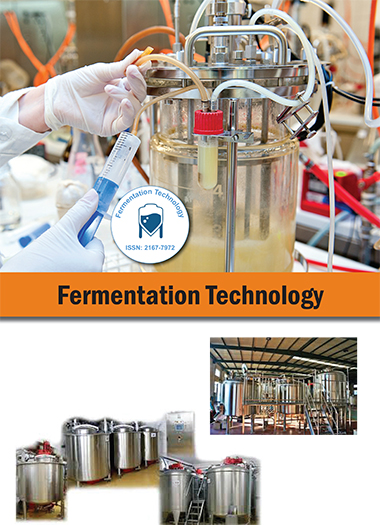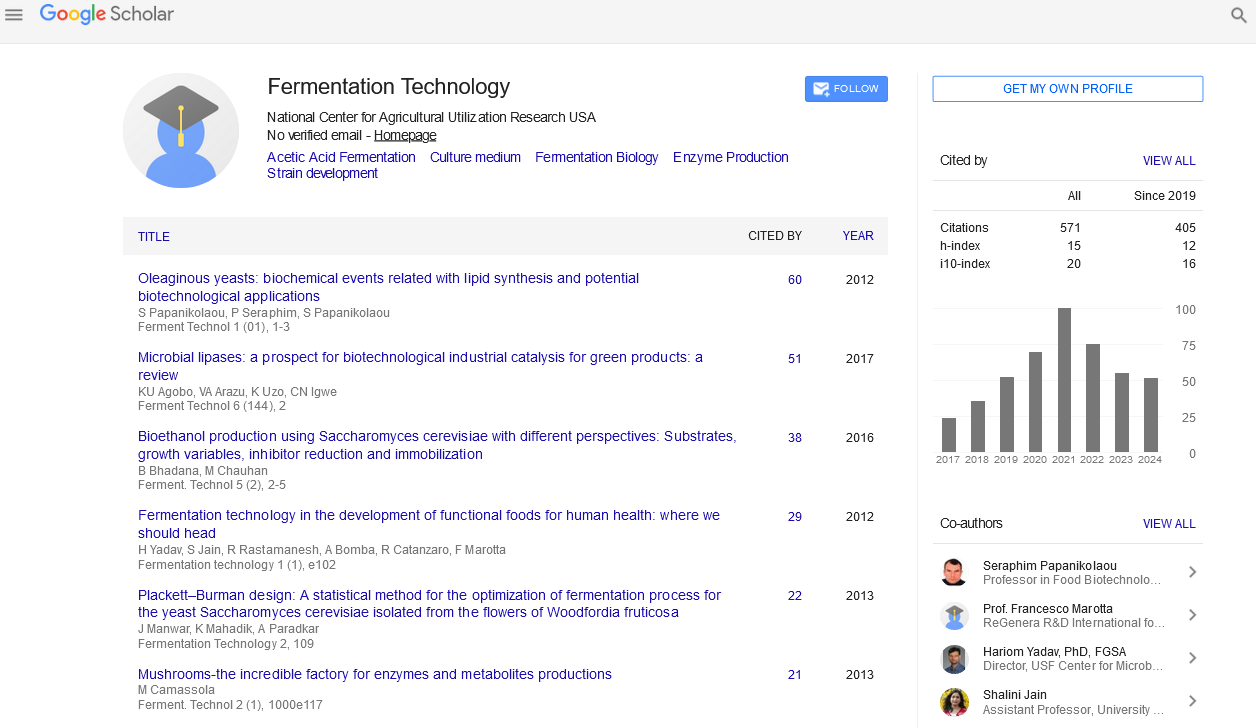Indexed In
- Open J Gate
- Genamics JournalSeek
- Access to Global Online Research in Agriculture (AGORA)
- RefSeek
- Hamdard University
- EBSCO A-Z
- OCLC- WorldCat
- Publons
Useful Links
Share This Page
Journal Flyer

Open Access Journals
- Agri and Aquaculture
- Biochemistry
- Bioinformatics & Systems Biology
- Business & Management
- Chemistry
- Clinical Sciences
- Engineering
- Food & Nutrition
- General Science
- Genetics & Molecular Biology
- Immunology & Microbiology
- Medical Sciences
- Neuroscience & Psychology
- Nursing & Health Care
- Pharmaceutical Sciences
Commentary - (2024) Volume 13, Issue 1
Innovative Materials: Exploring Novel Electrode Substrates in Anodic Electro-Fermentation
Lola Andrea*Received: 26-Feb-2024, Manuscript No. FMT-24-25551; Editor assigned: 28-Feb-2024, Pre QC No. FMT-24-25551 (PQ); Reviewed: 13-Mar-2024, QC No. FMT-24-25551; Revised: 20-Mar-2024, Manuscript No. FMT-24-25551 (R); Published: 27-Mar-2024, DOI: 10.4172/2167-7972.24.13.167
Description
Anodic electro-fermentation, an innovative approach in biotechnology, has been shown as a potential strategy to increase anaerobic production processes through anodic respiration. This innovative technique involves the connection of microbial metabolism with electrode reactions, supporting the direct conversion of organic substrates into valuable products. By controlling the power of electroactive microorganisms, anodic electro-fermentation offers new opportunities to improve process efficiency, product yields, and sustainability in various biotechnological applications.
Mechanisms of anodic electro-fermentation
Anodic electro-fermentation operates on the principle of anodic respiration, wherein electroactive microorganisms utilize electrodes as electron acceptors in lieu of traditional terminal electron acceptors like oxygen or nitrate. This unique metabolic direction allows microorganisms to generate energy through the oxidation of organic compounds while transferring electrons directly to the anode surface. The combination of electrodes in anaerobic bioreactors provides a conductive interface for microbial electron transfer, supporting efficient electron transport and increased metabolic activity.
Applications of anodic electro fermentation
The adaptability of anodic electro-fermentation extends to various sectors, including biofuel production, wastewater treatment, bioremediation, and biocommodity synthesis. In biofuel production, electro-fermentation provides a sustainable approach to increasing the yields of bioethanol, hydrogen, and other biofuels from various sources. Furthermore, the combination of electroactive microorganisms in Microbial Fuel Cells (MFCs) enables simultaneous energy generation and wastewater treatment, presenting potential methods for distributed wastewater management.
In bioremediation applications, anodic electro-fermentation has shown potential in the degradation of resistant pollutants and the recovery of valuable resources from contaminated environments. Moreover, the synthesis of bio-commodities, such as organic acids, alcohols, and biopolymers, via electrofermentation holds potential for the development of sustainable bioprocesses with minimized environmental impact.
Exploring novel electrode materials
An area of growing interest in anodic electro-fermentation is the exploration of novel electrode materials with customized properties to increase microbial electron transfer and catalytic activity. Recent advancements in nanotechnology and materials science have led to the development of conductive nanomaterials, such as carbon nanotubes, graphene, and conductive polymers, as alternative electrode substrates. These materials offer advantages such as high surface area, adjustable surface chemistry, and increased biocompatibility, making them beneficial options for improving the performance and stability of anodic electro-fermentation systems.
Challenges and future directions
Despite its immense potential, anodic electro-fermentation faces several challenges that must be addressed for extensive implementation. These include optimizing electrode materials and reactor configurations, increasing microbial electron transfer efficiency, and understanding the complex interactions within electroactive microbial communities. Additionally, exploring the potential for expansion and the economic feasibility of anodic electro-fermentation processes require further investigation to promote industrial adoption.
Future research efforts should focus on clarifying the fundamental mechanisms controlling anodic respiration and microbial-electrode interactions, controlling advanced omics technologies, electrochemical analyses, and computational modeling. Furthermore, interdisciplinary collaborations between microbiologists, electrochemists, engineers, and bioprocess experts are essential to drive innovation and overcome existing barriers in anodic electro-fermentation.
In conclusion, anodic electro-fermentation represents a change of opinion in anaerobic biotechnology, providing a sustainable and efficient approach to control microbial metabolism for various applications. By controlling on the unique capabilities of electroactive microorganisms and electrode materials, anodic electro-fermentation has the potential to change bioproduction processes, prepare for a more environmentally friendly and strong bio-economy. Continued research and development efforts, including the exploration of novel electrode materials, are essential to control the full potential of anodic electrofermentation and realize its transformative impact on industrial biotechnology.
Citation: Andrea L (2024) Innovative Materials: Exploring Novel Electrode Substrates in Anodic Electro-Fermentation. Ferment Technol. 13:167.
Copyright: © 2024 Andrea L. This is an open-access article distributed under the terms of the Creative Commons Attribution License, which permits unrestricted use, distribution, and reproduction in any medium, provided the original author and source are credited.

